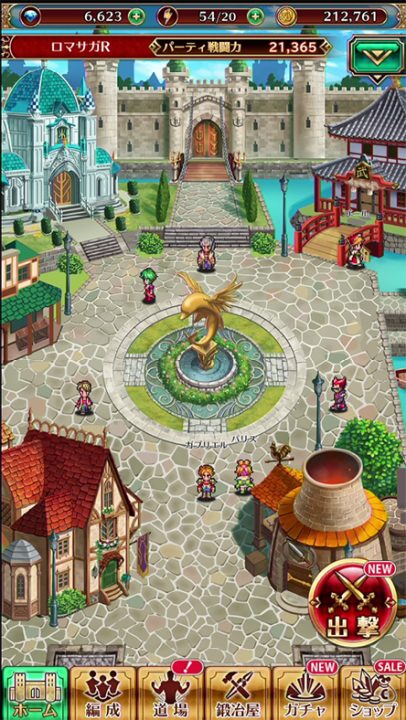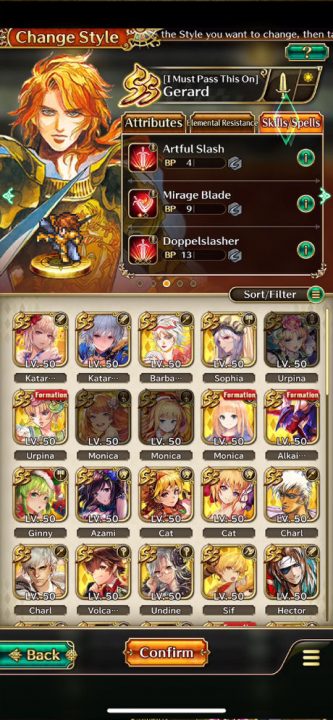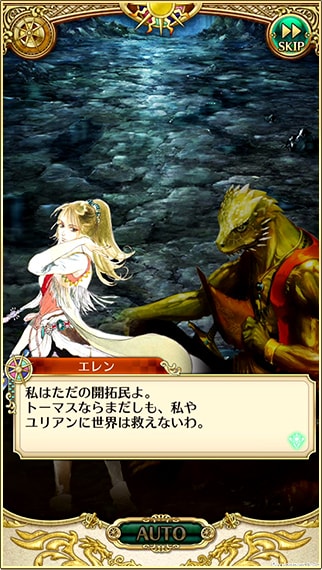Plenty of franchises have thrown their hat into the ring with a mobile title that mixes notable characters within their IP: Fire Emblem, Langrisser, Shin Megami Tensei, and multiple Final Fantasy titles. But Square Enix decided to take a risk with their SaGa title, Romancing SaGa Re;univerSe, developing it as a story-driven direct sequel to Romancing SaGa 3 (recently remade and localized for an English-speaking audience) while simultaneously featuring characters from throughout the rich and eccentric franchise.
I first became excited about this title after playing the closed beta and interviewing producer Masanori Ichikawa. Then, with the global public launch date set for late June, I pre-registered and was set to restart my campaign after the beta period.
In the subsequent months, Square Enix and Akatsuki have delivered in a big way. To make up for time lost since the 2018 Japanese release, time-limited events have been rolled out almost non-stop, sometimes overlapping. Various currencies used for trading and upgrading are lavished upon active players. In short: there is a ton of content, and the gacha system is generous enough that any player is sure to pick up at least a few of their favorite characters.

But the real genius of Romancing SaGa Re;univerSe, beyond the canon post-RS3 storytelling, is the “style” system. Almost every character in the game comes with at least two styles. These styles can be ranked as “A,” “S,” or “SS.” If you’ve played other games with gacha mechanics, you already know where this is going. But in this game, the more styles you have of the same character, the stronger all styles/forms of that character can become. For example, let’s say I start the game with a gacha roll that includes an SS style of Blue, the magic-user from SaGa Frontier. Two weeks later, I pick up an A style of the same character. If I have been grinding stat gains for the SS style through combat or expedition, A Blue also gains stat upgrades and can pull one of three abilities that only the SS form of Blue can use (and vice versa).
Additionally, each character is limited to one weapon type, but as you level characters (current level cap 50), there are points where that character/style gets points toward increasing weapon type mastery. At release, there were nine weapon types (short sword, sword, great sword, spear, bow, staff, hammer, axe, martial arts). A tenth weapon type, gun, was added when Emelia and T260G (from SaGa Frontier) were introduced. By increasing mastery, every single character/style using these weapons increases weapon damage, accuracy, and the likelihood of learning and ranking-up skills/spells via usage in battle. The rising tide lifts all boats in this game. It incentivizes developing your full entourage, though there are still benefits to having a select crew of primary characters.
Other interesting mechanics include enemy weakness and resistance. Here I will give an interesting example I recently discovered with the new “gun” weapon class. Guns traditionally do “blunt” style damage, one of the three physical damage types. However, Emelia’s skill “Sweet Trap” does both blunt and pierce damage. If an enemy is strong to one damage type but weak to another (or even just neutral to the other), the game will process the damage in favor of the more effective damage type. Thus, with one skill, Emelia can mow down enemies weak to Pierce or Blunt, regardless of their strengths against either damage type. When mixing in the five magic types (fire, water, lightning, sun, shadow), things get all the more interesting.
Combat itself has always been a key strength to the SaGa franchise and this is certainly true in Re;univerSe. Per series tradition, combat features five characters set into one of many available formations, most of whom are unlocked through story completion and earning special achievements. The formations tend to give stat boosts to certain positions with stat penalties for other positions (or spread equally around the party). Formation also matters for enemy attacks that have horizontal or vertical areas of effect. Not every SaGa game has this feature, though it was a major part of the strategic gameplay in both Romancing SaGa 3 and SaGa Scarlet Grace: Ambitions.
The game opened with four available chapters and rolled out new chapters every few weeks. At first, the main story seems somewhat milquetoast compared to its predecessor, but it doesn’t take long before the game’s 300-year time passage, as well as the ability to summon flash-frozen-in-time versions of other series characters, comes together in a way that actually makes sense. The planning of this game, as well as the actual dialogue, surpasses that of many other mobile games.

Additionally, a special mystery left over from Romancing SaGa 3 is introduced: namely, why has everyone forgotten about the character Sarah, one of the eight heroes from that title? The RS3 ending did not suggest she was forgotten, and history itself hasn’t forgotten her, but the summoned heroes from RS3 have all memories of her erased. With special side quests over time, each of these characters regains memories of her. Why this is, we’ll know eventually.
Other, smaller loose threads from nearly every game in the series begin to tie up. In fact, the game even pulls in the stories from the SaGa The Stage live performances about Romancing SaGa 2‘s Seven Heroes when they were still actually heroes, and also Romancing SaGa 3‘s four Sinistrals during the time from the beginning of the last Morastrum to the present day. I was also impressed by side stories for SaGa Frontier and SaGa Frontier 2 recapitulating important plot markers and clearing up unclear points from the original games, either because of limited storytelling at the time or poor localization. Either way, I can say that I understand Emelia, Asellus, and Cordelia as characters far better thanks to this game.
The newly-created original characters for this title — Polka Lyn Wood, his sister Liz, Mikhail’s descendant Zenon, the blue lobster Valdor, and many others — appear to be the weakest link at first. As the main story progresses, they become more interesting. Liz appears to be especially crucial, but even side characters like Valdor and Zenon have their charm. It is the protagonist Polka Lyn Wood who appears to be the true Mary Sue of the game (despite being male). With crossover content, it’s hard to develop a strong lead character, and there is almost nothing remarkable or worthwhile about Polka. Virtually every other character is more interesting than him.
Aesthetically, Re;univerSe has so much to offer, it’s insane. The published soundtrack demonstrated that while new and original music was generally mediocre, there is so much great existing music — original and arranged — throughout this series that the developers have plenty to choose from. And they have chosen well, for both main and side content. I was especially pleased to hear music from the recent re:birth arrange albums, and some OST music from Masashi Hamauzu’s SaGa Frontier 2. The music is a true delight, and they’ve done a great job selecting a large variety of tracks for the game’s many battles and story scenarios.

Visually, the game is remarkable. Maintaining a style true to form with the Romancing SaGa 3 remake on PS Vita and other platforms, new sprites were developed for characters in every other entry to match this style. Additionally, new sprites were developed so that the Seven Heroes from Romancing SaGa 2 could be added as playable characters. There is also a bevy of great character concept art: every unlocked “Style” has its own character portrait, and they tend to be quite beautiful. Most of them are done by Tomomi Kobayashi, the series artist mainly associated with SaGa. But other artists were recruited for new portraits, and the team used existing portraits from previous work done by other artists. When developer Akatsuki decided to make this game happen, they dug deep to really offer up everything that’s great about SaGa. And they’ve done a fine job.
With a compelling story that serves as a true-to-form “Romancing SaGa 3-2,” addictive combat, and excellent visuals and audio, there’s not much fault to find with this game. Presently, the bottleneck resource for progression in the game is just aurum (currency, money, gold, what have you). One can easily progress smoothly through the game without spending a penny, though microtransactions are available for the generous and/or impatient.
Whether you’re a series buff like me or a newcomer that wants to see what SaGa is all about, Romancing SaGa Re;univerSe is an encyclopedic phenomenon that’s so good, I cannot believe it’s free. And I will never stop being grateful that it actually got localized. Please, for the love of all that is good in JRPG-dom, check this game out.


